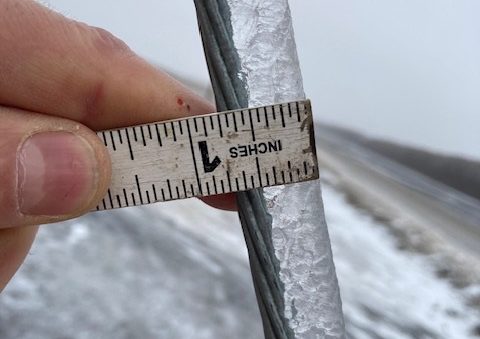It’s been a busy couple of days for Manitoba Hydro crews.
The Crown corporation said after about 6,000 customers lost power on Thursday before 4:30p.m., things are looking up now that the rain and snow have calmed.
“Feb. 9 — today — is quite a bit better,” said Riley McDonald, media relations assistant at Manitoba Hydro. “As of this morning at 4:30 a.m., there (were) 1,700 customer outages in the Portage (la Prairie) area, and that was restored by 7:50 a.m.,” he said.
But McDonald said the utility is left with icy power lines in some places, which can get heavy and in some cases break.
“Ice, in general, can be kind of tricky for hydro infrastructure, and it’s especially bad when it’s paired with wind,” he said.
This is because it can cause a phenomena called galloping lines.
Get the latest National news.
Sent to your email, every day.
“(With) that, what happens is ice accumulates on a power line and it forms almost a wing shape. Then, when the wind hits that wing, then it brings up the lines and then they drop again,” he said.
“It’s very interesting to watch. It kind of looks like the (transmission) towers are skipping rope.”
Even though it might look fun, McDonald said it’s not safe and to keep back. “Everybody should always treat every power line as live, but also when they’re galloping, they can throw ice. So you want to be really far away.”
He said crews are at the ready to keep the lights on with various techniques.
“We have a method called melting, which was invented by Manitoba Hydro,” he said. An article by Manitoba Hydro says in this de-icing process, “a controlled short-circuit is placed at one end of a line. The current flow creates a temperature increase that heats up the line and melts the ice.”
McDonald said, “that’s really interesting to watch too because, all of a sudden, it just falls away.” A video of ice melting went viral on social media platforms about a year ago.
Other techniques include removing power from the line and knocking ice off, McDonald said, and ice rolling.
With ice rolling, “they put a roller on a stick or a rope, and they put it on the power line,” he said, adding that as the roller is pulled down the line, it “cracks off the ice.”
As crews get on the road to address areas with outages, McDonald said to hold tight.
“Our crews use the same roads and highways as everybody else. So, if it’s super icy or there’s traffic disruptions, that might affect our ability to respond,” he said.
© 2024 Global News, a division of Corus Entertainment Inc.




